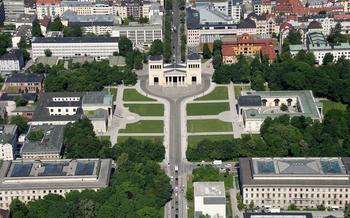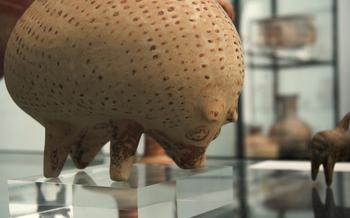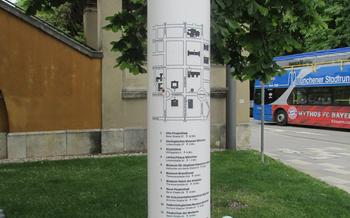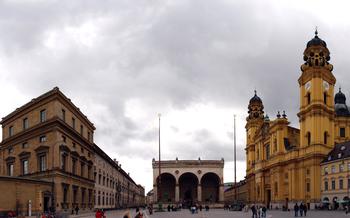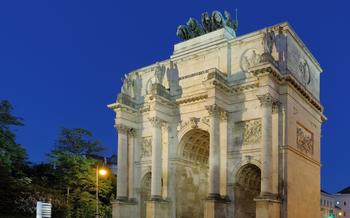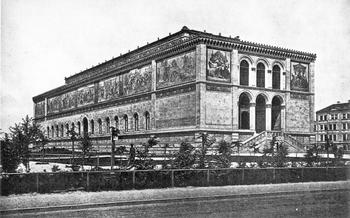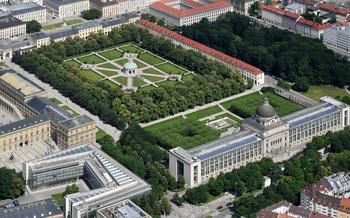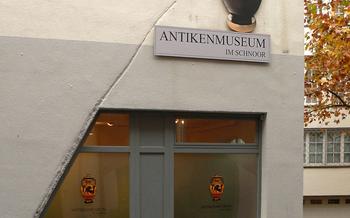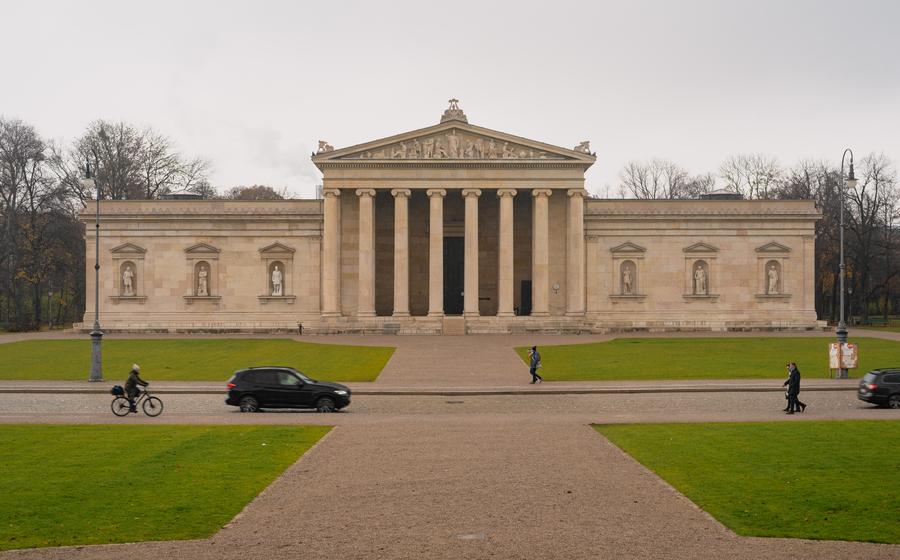
Glyptothek
- Glyptothek, Munich: An Ode to Ancient Sculpture
- Navigating the Museum: A Journey Through Time
- Exploring the Sculptures: Gods, Heroes, and Myths
- Egyptian Antiquities: A Glimpse into a Lost Civilization
- Greek and Roman Sculptures: The Golden Age of Art
- The Hall of Heroes: Celebrating Mortal Achievements
- The Pediments: Stories in Stone
- Masterpieces of the Glyptothek: Unveiling Hidden Gems
- Temporary Exhibitions: A Window to the Past
- Educational Programs and Workshops: Engaging with Art
- The Glyptothek Shop: Souvenirs and Treasures
- Planning Your Visit: Essential Information
- Exploring the Neighborhood: Beyond the Glyptothek
Glyptothek, Munich: An Ode to Ancient Sculpture
The Glyptothek in Munich, Germany, is a captivating museum dedicated to the art of ancient Greece, Rome, and Egypt. Founded by King Ludwig I of Bavaria in 1816, the Glyptothek was designed by the renowned German architect Leo von Klenze and completed in 1830. Its name, derived from the Greek words "glyptos" (carving) and "theke" (repository), reflects the museum's focus on stone sculptures. The Glyptothek's impressive collection, spanning from monumental statues to intricate reliefs, offers visitors a glimpse into the artistic achievements of ancient civilizations.
The Glyptothek's architectural style is a harmonious blend of Neoclassical and Greek Revival elements, echoing the museum's dedication to ancient art. The building features a majestic portico supported by Doric columns and topped with a triangular pediment, reminiscent of ancient Greek temples. The interior is characterized by spacious galleries arranged around a central courtyard, creating a serene and contemplative atmosphere conducive to appreciating the timeless beauty of the sculptures.
The Glyptothek holds a prominent position in Munich's vibrant art scene, serving as a hub for scholars, art enthusiasts, and tourists alike. Its collection is renowned for its exceptional quality and diversity, making it one of the most significant repositories of ancient sculpture in the world. The museum's proximity to other renowned cultural institutions, such as the Alte Pinakothek and the Neue Pinakothek, further enhances its allure as a must-visit destination for art lovers.
Getting to the Glyptothek is a breeze, thanks to its convenient location in the heart of Munich's historic center. Situated on Königsplatz, a grand square surrounded by several museums and cultural landmarks, the Glyptothek is easily accessible by public transportation, including the U-Bahn (subway) and trams. For those arriving by car, parking garages are available nearby, ensuring a hassle-free visit to this treasure trove of ancient art.
Navigating the Museum: A Journey Through Time
A visit to the Glyptothek offers a chronological journey through the history of ancient sculpture, beginning with the archaic period and culminating in the Hellenistic era. The museum is organized into thematic galleries, each showcasing a specific era or style. Highlights include the Hall of Gods, which houses impressive statues of major Greek and Roman deities, and the Hall of Heroes, which celebrates mortal achievements through sculptures of legendary figures from Greek mythology.
To fully appreciate the museum's vast collection, consider following a recommended route. Thematic tours are available, led by knowledgeable guides who provide insights into the history, techniques, and significance of the sculptures. Visitors can also explore at their own pace, using the provided maps and guides.
The Glyptothek is committed to accessibility and offers a variety of features to ensure a welcoming environment for all visitors. Wheelchair ramps, elevators, and accessible restrooms are available throughout the museum. Additionally, audio guides and tactile exhibits are provided for visitors with visual impairments.
Exploring the Sculptures: Gods, Heroes, and Myths
Amidst the awe-inspiring halls of the Glyptothek, visitors embark on a journey through ancient narratives, encountering a diverse array of sculptures that bring to life the gods, heroes, and myths of antiquity. One of the highlights of the collection is the iconic statue of Apollo of Tenea, a breathtaking rendition of the Greek god of music and healing. The sculpture captures Apollo in his youthful prime, exuding an aura of divine grace and harmony.
Another must-see masterpiece is the Head of Alexander the Great, a powerful portrayal of the legendary conqueror. The intricate details and lifelike expression convey the strength and ambition that defined Alexander's reign. For those fascinated by Greek mythology, the Heracles and the Nemean Lion group offers a captivating glimpse into the hero's epic battle with the fierce beast. The muscular physique of Heracles and the snarling ferocity of the lion create a dynamic composition that evokes both awe and admiration.
Venturing further into the galleries, visitors encounter the Sleeping Ariadne, a poignant depiction of the mythical princess as she rests peacefully after her abandonment by Theseus. The delicate features and graceful pose of Ariadne convey a sense of vulnerability and heartache. In contrast, the Laocoön and His Sons group presents a harrowing scene of struggle and despair, as the Trojan priest and his sons are entwined in the deadly coils of sea serpents. The expressive agony etched on their faces and the intricate rendering of their bodies convey the intensity of their suffering.
Through these exceptional sculptures, the Glyptothek offers a profound insight into the artistic prowess and storytelling abilities of ancient civilizations. Each piece invites visitors to delve into the rich tapestry of myths, legends, and heroic tales that shaped the cultural landscape of the ancient world.
Egyptian Antiquities: A Glimpse into a Lost Civilization
Amidst the treasures of the Glyptothek, the Egyptian collection stands out as a testament to the enduring legacy of an ancient civilization. Visitors are transported back in time as they encounter a diverse array of artifacts that unveil the stories, beliefs, and artistic prowess of ancient Egypt.
Among the highlights of the collection is a captivating series of sculptures depicting Egyptian gods and goddesses. These majestic figures, carved from stone or cast in bronze, exude an aura of power and divinity. The intricate details and symbolism embedded in each sculpture provide a glimpse into the religious beliefs and mythology that shaped ancient Egyptian society.
Another remarkable aspect of the collection is the array of funerary artifacts, including statues of the deceased, amulets, and intricately painted coffins. These objects offer insights into the ancient Egyptians' beliefs about the afterlife and their elaborate burial practices.
The Glyptothek's Egyptian collection also boasts a significant number of everyday objects, such as pottery, tools, and jewelry. These artifacts provide a tangible connection to the daily lives of ordinary Egyptians, shedding light on their customs, crafts, and social interactions.
By exploring the Egyptian antiquities at the Glyptothek, visitors gain a deeper understanding of a civilization that continues to captivate and inspire. The collection serves as a bridge between the present and the past, allowing visitors to connect with the rich history and cultural heritage of ancient Egypt.
Greek and Roman Sculptures: The Golden Age of Art
The Glyptothek houses an impressive collection of Greek and Roman sculptures, representing the pinnacle of ancient artistic achievement. These masterpieces showcase the evolution of sculpture from the archaic period, characterized by stiff and formal poses, to the classical period, which brought about a sense of naturalism and grace.
Among the highlights of the collection is the Barberini Faun, a bronze statue of a satyr discovered in Rome in the 17th century. The sculpture depicts the mythical creature in a playful and mischievous pose, capturing the essence of Greek mythology.
Another notable work is the Head of Apollo, a marble sculpture from the 5th century BC. The head exudes a sense of serenity and majesty, embodying the idealized beauty of the Greek gods.
The Glyptothek also boasts a collection of Roman sculptures, including the Augustus of Prima Porta, a marble statue of the Roman emperor Augustus. This iconic work portrays Augustus in a heroic pose, emphasizing his power and authority.
The Glyptothek's collection of Greek and Roman sculptures offers a glimpse into the artistic and cultural achievements of these ancient civilizations. Visitors can trace the development of sculpture over time, marvel at the skill and craftsmanship of the ancient sculptors, and gain a deeper understanding of the role of sculpture in ancient societies.
The Hall of Heroes: Celebrating Mortal Achievements
Amidst the divine figures of the Hall of Gods, the Glyptothek also pays homage to the extraordinary feats of mortal heroes in the Hall of Heroes. This section of the museum celebrates the strength, courage, and sacrifices of legendary individuals from Greek mythology.
The sculptures in the Hall of Heroes portray these heroes engaged in epic battles, enduring perilous quests, and demonstrating unwavering loyalty and resilience. Visitors can admire the heroic stance of Herakles as he battles the Nemean Lion, the determination of Perseus as he slays the monstrous Medusa, and the cunning of Odysseus as he outsmarts the Cyclops Polyphemus.
These sculptures not only showcase the physical prowess and bravery of these heroes but also highlight the moral values and virtues they embodied. They represent the ideals of justice, honor, and selflessness that were highly esteemed in ancient Greek society.
By immortalizing these heroic figures in stone, the ancient sculptors aimed to inspire future generations to emulate their noble qualities and strive for greatness. The Hall of Heroes serves as a reminder of the enduring legacy of these legendary individuals and their impact on the cultural and moral fabric of ancient Greece.
The Pediments: Stories in Stone
The pediments, or triangular gables, of ancient Greek temples served as prominent platforms for displaying mythological scenes in sculpted relief. The Glyptothek houses an impressive collection of pediments from various temples, each narrating a unique story in stone. One notable example is the pediment from the Temple of Aphaia on the island of Aegina, depicting the battle between Greeks and Trojans over the body of Patroclus. The intricate details and dynamic poses of the figures bring the epic battle to life, showcasing the skill and artistry of ancient Greek sculptors.
Another highlight is the pediment from the Temple of Zeus at Olympia, which portrays the preparations for a chariot race between Pelops and Oenomaus. The composition is characterized by a sense of movement and tension, as the figures seem to burst forth from the stone, capturing the anticipation and excitement of the event. These pediments offer a glimpse into the rich mythology and storytelling traditions of ancient Greece, providing valuable insights into the beliefs and values of the time.
Masterpieces of the Glyptothek: Unveiling Hidden Gems
Among the many treasures housed within the Glyptothek, several masterpieces stand out, captivating visitors with their exceptional beauty, historical significance, and artistic prowess. One such masterpiece is the Barberini Faun, a life-size bronze sculpture dating back to the 3rd century BCE. This remarkably well-preserved statue depicts a satyr, a mythical creature half-man, half-goat, in a moment of repose, leaning against a tree trunk. The intricate details of the musculature, the playful expression on the faun's face, and the skillful rendering of the fur create a sense of vitality and movement that is simply breathtaking.
Another highlight of the Glyptothek is the Sleeping Ariadne, a marble sculpture from the 2nd century BCE attributed to the renowned Greek sculptor, Polydorus of Rhodes. This sculpture captures the moment when Ariadne, the daughter of King Minos, lies asleep on the island of Naxos after being abandoned by Theseus. The delicate features of Ariadne's face, the soft folds of her drapery, and the intricate details of her jewelry convey a sense of vulnerability and pathos that is both poignant and captivating.
The Strangford Apollo, a marble statue from the 1st century BCE, is another must-see masterpiece. This sculpture depicts the Greek god Apollo, the epitome of beauty and perfection, standing in a relaxed pose, his weight shifted onto one leg. The god's serene expression, the harmonious proportions of his body, and the intricate details of his hair and drapery exemplify the ideals of classical Greek sculpture.
These masterpieces, along with many others, form the core of the Glyptothek's collection, offering visitors a glimpse into the extraordinary artistry and craftsmanship of ancient Greece and Rome. Each sculpture tells a story, reveals a myth, and embodies the cultural and religious beliefs of the ancient world. Discovering these hidden gems is like embarking on a journey through time, allowing visitors to connect with the past and appreciate the enduring legacy of classical art.
Temporary Exhibitions: A Window to the Past
The Glyptothek frequently hosts temporary exhibitions that complement its permanent collection and delve into specific themes or periods of ancient art. These exhibitions provide a dynamic and ever-changing experience for visitors, allowing them to explore new perspectives and gain deeper insights into ancient cultures.
Temporary exhibitions at the Glyptothek have covered a wide range of topics, from the art of specific ancient civilizations, such as the Etruscans or the Romans, to broader themes like the representation of the human body in ancient sculpture or the influence of ancient art on modern artists. The exhibitions often feature loans from other museums and institutions, bringing together a diverse array of masterpieces for a unique viewing experience.
Temporary exhibitions at the Glyptothek are typically accompanied by educational programs, lectures, and guided tours, offering visitors the opportunity to engage with the material in a deeper way. These programs provide expert insights into the themes and artworks on display, enhancing the overall visitor experience.
To stay updated on upcoming temporary exhibitions, visitors can check the Glyptothek's website or sign up for their email newsletter. The museum also actively promotes its temporary exhibitions on social media, providing sneak peeks and behind-the-scenes glimpses to generate excitement and interest among its followers.
By hosting temporary exhibitions, the Glyptothek demonstrates its commitment to presenting a dynamic and engaging experience for its visitors. These exhibitions not only showcase new and exciting artworks but also contribute to the museum's ongoing mission of fostering a deeper understanding and appreciation of ancient art and culture.
Educational Programs and Workshops: Engaging with Art
The Glyptothek offers a range of educational programs and workshops designed to engage visitors of all ages with the museum's collection and the world of ancient sculpture. These initiatives provide opportunities for hands-on experiences, art appreciation, and a deeper understanding of the cultural and historical significance of the Glyptothek's treasures.
Workshops for children and families allow young visitors to explore the museum's sculptures through interactive activities, storytelling, and creative projects. These workshops foster creativity, encourage curiosity, and spark a lifelong interest in art and history.
Lectures and guided tours led by experienced art historians and educators delve into the stories, techniques, and symbolism behind the sculptures, providing visitors with a deeper understanding of the ancient world and its artistic traditions.
The Glyptothek also collaborates with universities and institutions to offer specialized workshops and courses for students and scholars. These programs provide opportunities for in-depth study and research, encouraging the next generation of art historians and enthusiasts.
Through these educational programs and workshops, the Glyptothek fulfills its mission to foster creativity, knowledge, and appreciation for the art of ancient Greece and Rome, ensuring that its timeless legacy continues to inspire and educate future generations.
The Glyptothek Shop: Souvenirs and Treasures
The Glyptothek offers a well-stocked shop where visitors can find a variety of souvenirs and merchandise to remember their visit. From books and postcards to replicas of ancient sculptures and unique gifts inspired by the collection, there's something for every taste and budget.
The shop is conveniently located near the museum's exit, making it easy for visitors to browse and purchase items before leaving. The friendly and knowledgeable staff is always ready to assist customers and provide recommendations based on individual preferences.
By purchasing souvenirs from the Glyptothek shop, visitors not only take home tangible reminders of their experience but also support the museum's ongoing efforts to preserve and promote ancient art. The revenue generated from the shop helps fund educational programs, conservation projects, and new acquisitions, ensuring that future generations can continue to appreciate the treasures of the Glyptothek.
Whether you're looking for a unique gift for a loved one, a special memento for yourself, or simply a way to contribute to the preservation of ancient art, the Glyptothek shop is a must-visit destination. Take your time browsing the selection, and don't forget to ask for assistance if you need help finding the perfect souvenir.
Planning Your Visit: Essential Information
Practical information is vital for ensuring a smooth and enjoyable visit to the Glyptothek. Plan your visit wisely to make the most of your time in this remarkable museum.
Operating Hours and Admission Fees:
- The Glyptothek's doors are open from Tuesday to Sunday, from 10 am to 5 pm.
- Regular admission tickets cost 7 euros for adults and 5 euros for concessions, including students and seniors.
- Family tickets are available for 15 euros, offering a discounted rate for groups of up to two adults and three children.
- Free admission is granted to visitors under 18, holders of the Munich PASS, and members of the Glyptothek Freunde (Friends of the Glyptothek).
Tips for a Pleasant Visit:
- To avoid crowds and ensure a more relaxed experience, plan your visit for a weekday.
- The museum is busiest during the summer months, especially in July and August. If possible, aim for a shoulder season visit (May-June or September-October) to enjoy a quieter atmosphere.
- Allow at least two hours to explore the Glyptothek's collection thoroughly.
- Comfortable shoes are recommended as you will be doing a lot of walking.
- Photography is permitted without flash for personal, non-commercial use.
Visitor Facilities:
- The Glyptothek provides cloakrooms to store coats, bags, and umbrellas.
- Restrooms are conveniently located within the museum.
- A museum shop offers a wide range of souvenirs, books, postcards, and replicas inspired by the collection.
- A small café is available for visitors to purchase refreshments and light snacks.
Accessibility for Visitors with Disabilities:
- The Glyptothek is wheelchair accessible, with ramps and elevators providing access to all levels of the museum.
- Wheelchair users can borrow wheelchairs free of charge at the information desk.
- Guided tours for visitors with visual or hearing impairments are available upon request.
- Braille guides and audio guides with descriptive content are also available for visitors with visual impairments.
Exploring the Neighborhood: Beyond the Glyptothek
A visit to the Glyptothek can be effortlessly combined with other cultural and historical experiences in the surrounding area. Just a short stroll away, visitors can immerse themselves in the captivating world of art at the Alte Pinakothek, home to a remarkable collection of paintings from the 14th to the 18th centuries. For those seeking a deeper understanding of ancient cultures, the Staatliches Museum Ägyptischer Kunst, located nearby, offers an extensive array of Egyptian artifacts, including mummies and hieroglyphics.
To satisfy culinary cravings, the neighborhood surrounding the Glyptothek is teeming with charming cafes, inviting restaurants, and traditional Bavarian beer gardens. Indulge in local delicacies, sip on a refreshing beverage, and soak up the vibrant atmosphere of Munich's culinary scene.
Art enthusiasts will delight in exploring the plethora of galleries and studios tucked away in the picturesque streets. Discover emerging talents, admire contemporary masterpieces, and take home a unique souvenir to cherish.
For a relaxing interlude, take a leisurely stroll through the tranquil Englischer Garten, one of the largest urban parks in the world. With its sprawling lawns, serene lakes, and enchanting beer gardens, it offers a welcome respite from the hustle and bustle of city life.
By venturing beyond the Glyptothek, visitors can create a well-rounded itinerary that encompasses art, history, gastronomy, and nature, ensuring a truly unforgettable experience in Munich.
